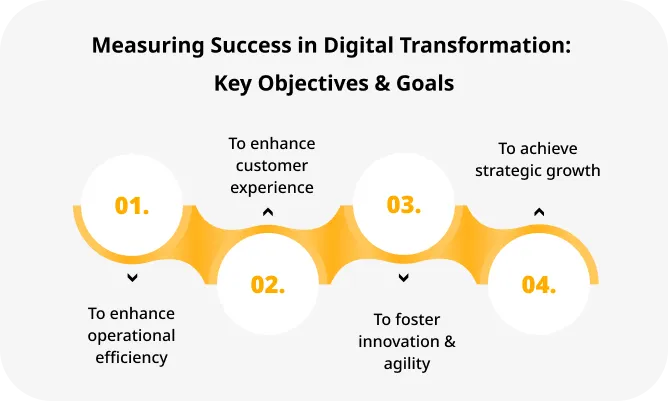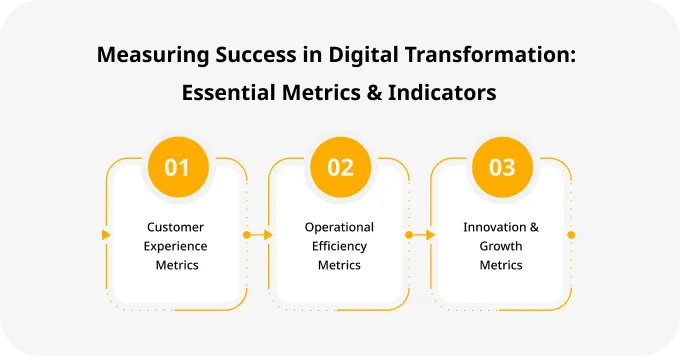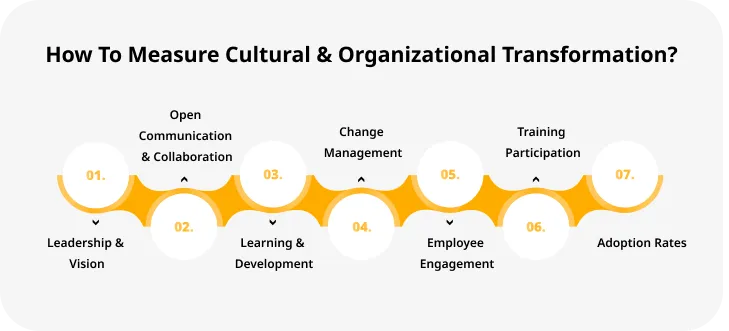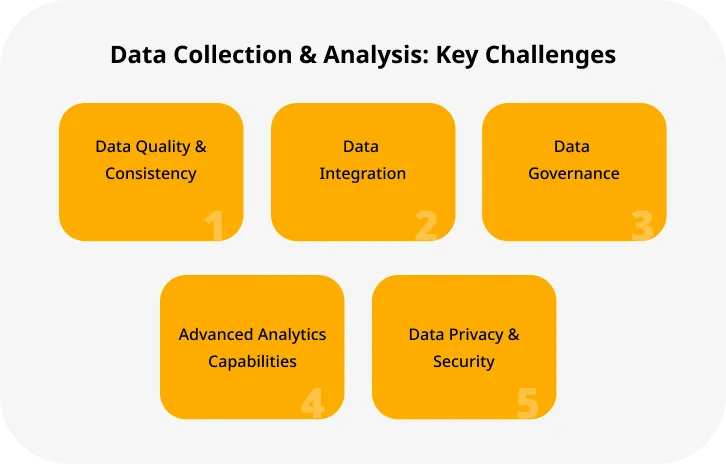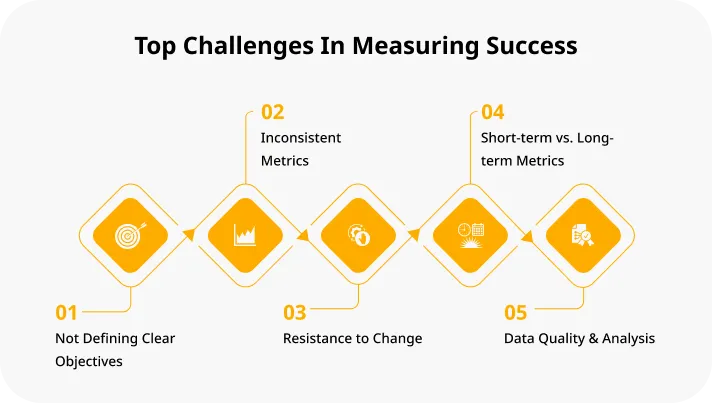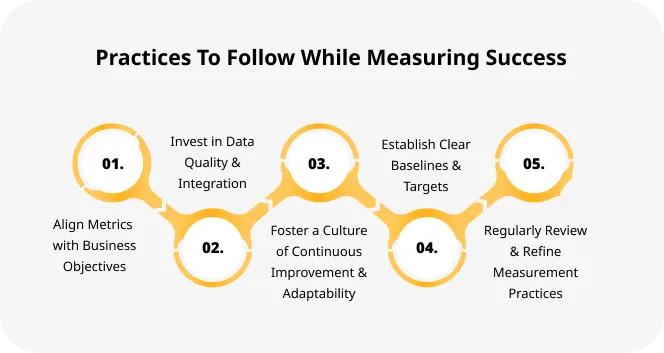Digital transformation promises increased efficiency, innovation & growth. Hence, businesses must embrace digital transformation strategies to stay competitive in this modern era.
But how can you measure the success of your digital efforts?
Don’t know?
This blog post will let you explore the key metrics & indicators that can help organizations gauge the effectiveness of their digital transformation initiatives by providing valuable insights into the journey toward a digitally empowered future.
Defining Success in Digital Transformation
Success in digital transformation goes beyond the mere implementation of new technologies. It encompasses the holistic transformation of business processes, customer experiences, and organizational culture.
However, the path to success in the digital transformative journey is not always clear. To effectively measure success in digital transformation, companies must establish clear objectives, & benchmarks.
Need for Clear Objectives & Benchmarks
Clear objectives provide direction and help organizations stay focused on their desired outcomes. When setting objectives, it is crucial to ensure they are SMART, i.e.,
- Specific
- Measurable
- Attainable
- Relevant
- Time-bound
Benchmarks, on the other hand, act as reference points against which progress can be measured. It can be both internal and external.
To measure success in digital transformation, organizations should identify & track key metrics and indicators that align with their objectives. Some common metrics include:
- Revenue Growth: This metric tracks the revenue generated from new products or digital consulting services launched due to digital transformation efforts
- Cost Reduction: A digital transformation strategy can lead to cost savings through process automation, improved efficiency, and optimized resource allocation.
- Customer Satisfaction: Measuring customer satisfaction through surveys, feedback mechanisms, and Net Promoter Score provides insights into the success of digital initiatives.
- Employee Engagement: Monitoring employee engagement levels, such as through surveys or employee feedback, can help gauge the effectiveness of transformation efforts in fostering a positive work culture.
Track success with our expert insights.
Key Objectives & Goals
Organizations can measure their success in digital transformation by aligning the key objectives & goals with the overall business strategy.
Let’s have a look at some:
To Enhance operational efficiency
By leveraging digital technologies & automation, businesses can streamline their processes, reduce manual errors, and optimize resource allocation. This objective is particularly important for organizations looking to:
- Improve productivity
- Reduce costs
- Gain a competitive edge
To enhance customer experience
Digital transformation strategy allows organizations to leverage data & analytics to get valuable insights into customer preferences, behavior and needs. This objective is crucial for organizations that want to:
- Build strong customer relationships
- Increase customer loyalty
- Drive revenue growth
To foster innovation & agility
Businesses often create a culture of innovation by embracing emerging technologies & digital platforms. This enables them to adapt quickly to market changes & capitalize on new opportunities.
This objective is particularly relevant for organizations operating in dynamic and competitive industries.
To achieve strategic growth
Businesses can expand into new markets by leveraging digital technologies, diversify their product offerings, and forge strategic partnerships.
This objective is vital for organizations that want to:
- Achieve sustainable growth
- Increase market share
- Create new revenue streams
Also read: Top 22 Digital Transformation Companies You Must Consult
Essential Metrics & Indicators
Measuring success in digital transformation by an eCommerce development services company requires organizations to identify & track key metrics/indicators across various dimensions.
Organizations could gain valuable insights into their progress & make data-driven decisions to drive success by understanding & monitoring these metrics:
Customer Experience Metrics
Net Promoter Score: NPS measures customer loyalty & satisfaction by asking them how likely their customers are to recommend a company’s products/services to others.
Customer Satisfaction: CSAT measures customer satisfaction with specific interactions or experiences.
Customer Lifetime Value: CLV quantifies the total value a customer brings to a business over their entire relationship.
Operational Efficiency Metrics
Cost Reduction: Cost reduction metrics assess the financial impact of digital transformation efforts.
Process Automation Rate: This metric measures how manual processes have been automated.
Time to Market: Time to market measures the speed at which an organization can bring new products or enterprise software development services to market.
Innovation & Growth Metrics
Revenue from New Products: This metric tracks the revenue generated from new products or services launched due to digital transformation efforts.
Market Share Expansion: Market share expansion measures a company’s market share growth.
Innovation Index: The innovation index assesses an organization’s ability to innovate & adapt to changing market dynamics.
Discover the metrics that matter.
Measuring Cultural & Organizational Transformation
The success of a company’s digital transformation strategy depends not only on the technology itself but also on how well the organization embraces & adapts to the changes.
Cultural aspects determine employees’ mindsets, attitudes, and behaviors toward the new digital initiatives. Here are some key cultural factors that contribute to the overall success of digital transformation:
Leadership & Vision: When leaders actively support and champion the transformation, it creates a sense of purpose and direction for the organization.
Open Communication & Collaboration: Digital transformation requires a collaborative & transparent work environment where organizations must foster open communication channels that encourage employees to share ideas, provide feedback, etc.
Learning & Development: Organizations should invest in training programs and provide learning opportunities to help employees adapt to the changing digital landscape.
Change Management: Effective change management strategies must address employee concerns, manage resistance, and ensure a smooth transition.
When measuring the success of digital transformation consulting services, several metrics can provide insights into the cultural aspects and overall progress.
Here are some key metrics to consider:
Employee Engagement: Surveys, feedback sessions, and pulse checks can be used to assess employee satisfaction, motivation, and alignment with the transformation goals.
Training Participation: Higher participation rates suggest a more engaged workforce and a culture that values continuous learning.
Adoption Rates: The adoption rates of new digital tools, processes, or systems can provide insights into how well the organization is embracing the changes.
Balancing Short-Term Gains with Long-Term Impact
Digital transformation initiatives often involve significant time, money, and resources investment. As a result, organizations naturally seek to see tangible results in the short term.
However, focusing solely on immediate ROI can be shortsighted and hinder long-term success. Therefore, it is crucial to balance short-term gains and long-term impacts.
Short-term financial metrics include:
- Increased revenue
- Cost savings
- Improved operational efficiency
These metrics help organizations gauge the effectiveness of their initiatives and justify the investments made. However, they only tell part of the story.
To truly measure the success of digital transformation, organizations must also consider long-term indicators of innovation and competitive advantage. These indicators include factors like:
- Customer satisfaction
- Employee engagement
- Market share growth
- Ability to adapt to changing market conditions
Also read: Digital Transformation: Top Strategies For Modernizing Your Business
Data Collection & Analysis Challenges & Solutions
Data has become a valuable asset for organizations in this modern era. It provides insights, drives decision-making, and helps measure the success of digital initiatives.
However, collecting, integrating, and analyzing data can present several challenges that organizations must overcome to ensure accurate measurement.
Here are some key challenges to consider:
Data Quality & Consistency
Organizations often have data scattered across various systems, in different formats, and with varying levels of accuracy.
Organizations should establish data quality standards, implement data cleansing processes, and ensure data integrity throughout the collection and integration phases to address this challenge.
Data Integration
Integrating data from multiple sources might be complex, especially with legacy systems or disparate databases. Data integration challenges include:
- Data mapping
- Data transformation
- Inconsistencies between different data sets
Organizations should invest in robust data integration tools and technologies to streamline the process and ensure data accuracy and consistency.
Also Read: The Role of Digital Transformation in Product Engineering
Data Governance
Proper data governance can lead to data silos, security breaches, and compliance issues.
Establishing a strong data governance framework can be crucial for ensuring data quality, privacy, and security. It involves:
- Defining data ownership
- Implementing data access controls
- Establishing data management processes
Advanced Analytics Capabilities
Many organizations struggle with limited resources, a lack of skilled personnel, or outdated analytics tools.
Investing in modern analytics platforms, leveraging artificial intelligence and machine learning technologies, and upskilling employees in data analysis can help overcome these challenges and enable organizations to make data-driven decisions.
Data Privacy & Security
Organizations must prioritize data privacy and security with increasing data collection. Compliance with data protection regulations, i.e. the General Data Protection Regulation, is essential.
Organizations should implement robust security measures, including encryption, access controls, and regular data audits, to protect sensitive data and maintain customer trust.
To overcome these data-related challenges, organizations can adopt the following strategies:
- Establish a Data Governance Framework
- Invest in Data Integration Tools
- Enhance Analytics Capabilities
- Prioritize Data Privacy and Security
Explore key indicators for digital transformation.
Key Challenges in Measuring Success
Measuring the success of a digital transformation strategy could be complex & challenging for organizations.
Let’s delve into some of the key challenges given below:
Not Defining Clear Objectives: Without well-defined goals, it becomes challenging to determine success and how to measure it effectively.
Inconsistent Metrics: Different organizational stakeholders may have varying perspectives on what metrics are important, leading to a lack of alignment and confusion.
Resistance to Change: Employees may resist adopting the latest technologies, processes, or ways of operating, which can hinder the success of these initiatives.
Short-term vs. Long-term Metrics: Balancing short-term and long-term metrics is another pain point in measuring digital transformation strategy success.
Data Quality & Analysis: Inaccurate/incomplete data can lead to flawed analysis and misleading conclusions.
By overcoming these challenges, organizations can effectively measure the success of their digital transformation initiatives & make informed decisions to drive further improvements.
Also read: How Artificial Intelligence Is Redefining Success Of Digital Transformation Strategies?
Best Practices for Measuring Success
Measuring the success of digital transformation can be crucial for organizations to understand the impact of their efforts & make informed decisions.
To ensure accurate and meaningful measurement, organizations should follow the following best practices:
Align Metrics with Business Objectives
This type of alignment ensures that the metrics chosen are relevant and directly contribute to the organization’s strategic goals.
In fact, organizations can measure the impact of digital transformation strategy on key performance indicators by focusing on metrics that align with business objectives.
Invest in Data Quality & Integration
Accurate measurement relies on high-quality data that is integrated from various sources. Hence, organizations should invest in data quality management processes and tools to ensure that the data used for measurement is reliable, consistent, and up-to-date.
Additionally, robust data integration practices and technologies can help streamline collecting and integrating data from different systems, ensuring a comprehensive view of the organization’s performance.
Foster a Culture of Continuous Improvement and adaptability
Organizations should encourage a mindset that embraces change, innovation, and learning. This includes promoting a culture where employees are encouraged to experiment, take calculated risks, and learn from failures.
Organizations can iterate on their measurement practices and adapt them to evolving business needs by fostering a culture of continuous improvement.
Establish Clear Baselines & Targets
Baselines provide a starting point for measurement and allow organizations to track progress over time. Targets, on the other hand, set specific goals that organizations strive to achieve.
Organizations could monitor their progress, identify areas for improvement, and celebrate milestones along the digital transformation strategy journey by setting clear baselines and targets.
Regularly Review & Refine Measurement Practices
Organizations should regularly review & refine their measurement approaches to remain relevant and effective. This includes:
- Evaluating the metrics being used
- Exploring new measurement techniques/tools
- Seeking feedback from stakeholders
By continuously reviewing & refining measurement practices, organizations can stay agile and ensure their measurement efforts align with evolving business needs.
Also read: Factors To Consider For Measuring E-Commerce Success
Future Trends in Measuring Digital Transformation Success
As technology continues to advance, new trends & technologies are emerging that will significantly impact how organizations measure success in the future.
Let’s explore some of these emerging trends & their potential implications for measuring digital transformation success:
AI-driven Analytics
Artificial Intelligence is revolutionizing the way organizations analyze & interpret data. AI-driven analytics tools can process vast amounts of data in real time. It provides valuable insights and predictive capabilities.
By leveraging AI algorithms, organizations can gain a deeper understanding of their digital transformation efforts and identify areas for improvement.
These advanced analytics solutions can help measure success by tracking key performance indicators and providing actionable recommendations for optimizing digital transformation strategies.
Predictive Modeling
Predictive modeling is another trend that will shape the future of measuring digital transformation strategy success. By utilizing historical data & machine learning algorithms, organizations can forecast future outcomes and trends.
This enables them to make data-driven decisions and adjust their digital transformation strategies accordingly.
Predictive modeling can help identify potential roadblocks, anticipate customer needs, and optimize resource allocation, ultimately leading to more successful digital transformations.
Holistic Experience Measurement
As we know, customer experience is a critical factor in determining the success of digital transformation strategy. Traditional metrics like conversion rates and customer satisfaction scores are no longer sufficient.
Organizations must adopt a holistic approach to measuring customer experience by considering multiple touchpoints across various channels. This includes analyzing user behavior, sentiment analysis, and customer journey mapping.
By capturing and analyzing data from these diverse sources, organizations can comprehensively understand the customer experience and make data-driven improvements to their digital transformation strategies.
Also read: How Digital Transformation Is A Decisive Factor For Business Turnaround
Conclusion
So far, we have seen that measuring the success of a digital transformation strategy requires carefully selecting key metrics & indicators that align with the organization’s goals and objectives.
It is crucial to continuously monitor & analyze these metrics to identify areas for improvement and make data-driven decisions.
Ultimately, success in digital transformation is about implementing the latest technologies and leveraging them strategically to drive meaningful outcomes and stay ahead in today’s rapidly evolving digital landscape.
Moreover, you can contact a reliable software product development services company like ValueCoders to transform your business digitally.



